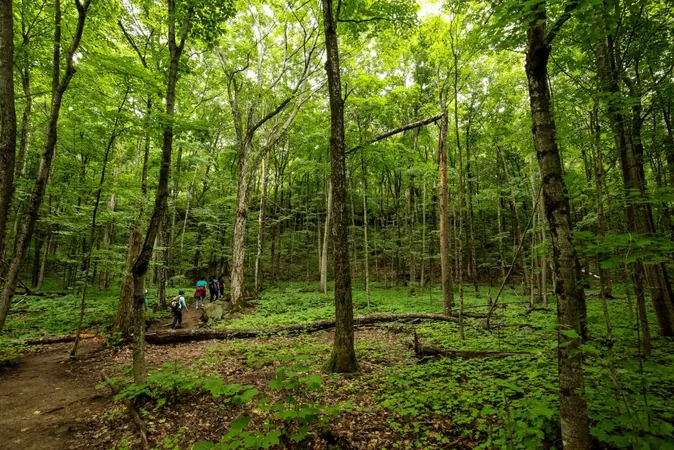
The Hidden Danger Beneath Our Feet: Blastomycosis Emerges as a Silent Killer
2025-08-27
Author: Jacques
An Unexpected Diagnosis: The Begining of Caleb Fogal's Nightmare
Caleb Fogal thought he was just dealing with a muscle tear when a painful abscess appeared in his right elbow in September 2023. At just 21, a healthy fourth-year student at Carleton University in Ottawa, he had zero medical issues on his record. But as the lump grew and the pain intensified, he sought help, unaware that he was about to confront a life-threatening fungal infection known as blastomycosis.
Struggling for Answers: The Long Road to Understanding
After a grueling 12-day investigation involving numerous biopsies and tests, doctors finally diagnosed him with blastomycosis, an infection that poses severe health risks. Unfortunately, Fogal’s condition rapidly deteriorated as he battled the effects of this rare fungus, leaving him in a dire situation.
A Growing Epidemic: The Mystery of Blastomycosis in Canada
Despite being a notable health hazard, data on blastomycosis is alarmingly sparse. Researchers are still unable to determine if the infection is endemic—permanently established in certain regions. Currently, Ontario and Manitoba are the only provinces mandated to report cases. Emily Acheson, a spatial epidemiologist, emphasized the need for comprehensive soil testing and accurate case tracking to combat this silent threat.
The Fungus That Thrives: Climate Change and Blastomycosis
Historically, the cooler climates of Canada kept infectious fungi like blastomyces at bay. However, climate change is altering that balance, creating ideal conditions for this dangerous organism to flourish. Milder winters and increased rainfall offer the conditions needed for blastomyces to not just survive, but thrive.
Why Early Detection is Crucial for Survival
In early cases like Fogal's, early diagnosis is critical. In treated patients, the mortality rate is between 0-2%, but skyrockets to 42% if left untreated. Unfortunately, the symptoms of blastomycosis can easily mimic common infections, leading to misdiagnosis.
The Struggles of Diagnosis: Caleb's Journey Through Hospital Care
As Fogal’s health declined in the hospital, doctors wrestled with inaccurate assumptions, initially diagnosing him with bacterial pneumonia and even suspecting tuberculosis. Two weeks later, after a crucial suggestion from a family member, the medical team finally tested for blastomycosis, which revealed a positive culture.
A Dogged Fight for Life: From Coma to Recovery
Just days after his diagnosis, Fogal’s health sank rapidly. He was transferred to ICU, intubated, and placed in a medically induced coma. The situation was so serious that doctors warned his family to prepare for the worst.
Revealing the Hidden Risk: What You Need to Know About Blastomycosis
Blastomycosis, also known as Gilchrist's disease, lurks in moist soil near bodies of water. Disturbing contaminated soil can release airborne spores, which can remain dormant inside the body for weeks. Symptoms may take up to months to surface, with only about half of exposed individuals falling ill.
Climate Concerns: The Risk is Rising
Despite being infrequently reported, incidences of blastomycosis are on the rise, with Public Health Ontario documenting 116 cases in 2023, up from 81 in the past. There are significant concerns regarding Indigenous populations, who face higher risks possibly due to environmental exposure.
Caleb's Remarkable Recovery: A New Lease on Life
Caleb eventually awakened from his coma and navigated the grueling path of recovery. Though he faced challenges with mobility and memory, he has no lasting medical complications. Now, almost two years later, his experience has transformed into a hazy memory, though he remains cautious about returning to the hiking trails where it all began.
Conclusion: The Health System Must Steer Attention Towards Blastomycosis
As blastomycosis continues to pose a growing threat, emphasis must be placed on understanding its implications better. With the changing climate fostering conditions for its spread, the healthcare system needs to direct more resources toward recognizing and treating this silent infection. Awareness could be the key to saving lives.









 Brasil (PT)
Brasil (PT)
 Canada (EN)
Canada (EN)
 Chile (ES)
Chile (ES)
 Česko (CS)
Česko (CS)
 대한민국 (KO)
대한민국 (KO)
 España (ES)
España (ES)
 France (FR)
France (FR)
 Hong Kong (EN)
Hong Kong (EN)
 Italia (IT)
Italia (IT)
 日本 (JA)
日本 (JA)
 Magyarország (HU)
Magyarország (HU)
 Norge (NO)
Norge (NO)
 Polska (PL)
Polska (PL)
 Schweiz (DE)
Schweiz (DE)
 Singapore (EN)
Singapore (EN)
 Sverige (SV)
Sverige (SV)
 Suomi (FI)
Suomi (FI)
 Türkiye (TR)
Türkiye (TR)
 الإمارات العربية المتحدة (AR)
الإمارات العربية المتحدة (AR)